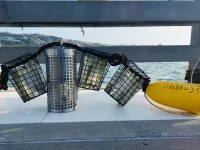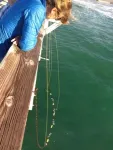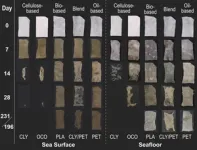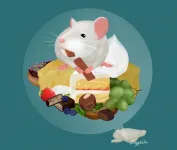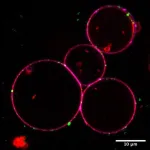(Press-News.org) Plastic pollution is seemingly omnipresent in society, and while plastic bags, cups, and bottles may first come to mind, plastics are also increasingly used to make clothing, rugs, and other textiles.
A new study from UC San Diego’s Scripps Institution of Oceanography, published May 24 in the journal PLOS One, for the first time tracked the ability of natural, synthetic, and blended fabrics to biodegrade directly in the ocean.
Lead author Sarah-Jeanne Royer conducted an experiment off the Ellen Browning Scripps Memorial Pier and found that natural and wood-based cellulose fabrics degraded within a month. Synthetic textiles, including so-called compostable plastic materials like polylactic acid (PLA), and the synthetic portions of textile blends, showed no signs of degradation even after more than a year submerged in the ocean.
“This study shows the need for standardizing tests to see if materials promoted as compostable or biodegradable actually do biodegrade in a natural environment,” said Royer, who performed the research while a postdoctoral scholar in the Dimitri Deheyn laboratory at Scripps Oceanography. Royer currently remains affiliated with Scripps Oceanography as a visiting scholar from Hawaiʻi Pacific University. “What might biodegrade in an industrial setting does not necessarily biodegrade in the natural environment and can end up as marine and environmental pollutants.”
Startling images of landfills stacked with mountains of thrown away clothing in Chile and Kenya show the global ramifications of fast fashion. An estimated 62 percent of textiles — 68 million tons — are now made from plastic fibers and plastic blends, which can persist in the environment for decades to centuries. Synthetic textiles also create plastic pollution from microfibers shedding during regular wearing and washing. Most washing machines are not designed to filter for microfibers, that then end up in wastewater, and ultimately the ocean.
Bio-based plastics made from renewable natural resources such as cornstarch or sugar cane have been marketed as a potential solution to the plastic problem. PLA is one such polymer in the bio-based plastics market, often labeled as biodegradable and compostable. The team chose this textile for the study given its extensive use as a replacement for oil-based materials.
For the experiment, ten different types of fabrics were used including wood-based cellulose (known commercially as Lyocell, Modal, and Viscose); natural cellulose (organic virgin cotton and non-organic virgin cotton); bio-based plastic (PLA); oil-based plastic (polyethylene terephthalate and polypropylene), and fabric blends of Lyocell mixed with polyester and polypropylene. All these are commonly used in the textile industry. Polyethylene terephthalate is a type of polyester often marketed as a recycled textile. Polypropylene is used in textiles, carpets, geotextiles, packaging materials, and disposable medical textiles such as masks.
The textile samples were placed in flow-through containers deployed both at the sea surface and at the seafloor approximately 10 meters (32 feet) deep. Samples were examined every seven days with images taken, and small pieces removed from duplicate samples for further examination in the lab. This included scanning electron microscopy to examine the fibers at high resolution, and Raman spectroscopy to gain information about the chemical composition and molecular structure of the fibers. The samples were then submerged again, in a process that lasted for 231 days at the sea surface and 196 days at the seafloor.
After the conclusion of the Scripps Pier experiment, the samples were moved to the Experimental Aquarium at Scripps Oceanography, where samples were exposed to controlled conditions of flowing seawater. While the natural, cellulose-based textiles repeatedly disintegrated in 30-35 days, the oil-based and bio-based materials showed no sign of disintegration even after a total of 428 days.
“The natural, cellulose-based materials would disintegrate in about one month, so we would exchange for a new sample after the old one disintegrated,” said Royer. “The natural samples were replicated five times, while the plastic samples remained the same for more than a year.”
Examining the samples via electron microscopy allowed Scripps marine biologist Dimitri Deheyn, senior author of the study, to measure the size and structure of each fiber. The natural fibers became thinner with time, while the diameter of the plastic fibers remained the same showing no sign of biodegradation. Study co-author Francesco Greco performed the Raman spectroscopy analysis at the Department of Geology of Northwest University, China, looking at the structural-chemical degradation of the fibers. Greco, now at the Weizmann Institute of Science, found significant changes in the chemical fingerprint of the cellulose-based materials, while bio- and oil-based plastics remained unchanged.
Fiber blends, which interweave natural fiber strands with bio- or oil-based plastic strands, are often promoted as a more sustainable alternative to textiles made entirely from synthetic plastics. This study showed, however, that only the natural part of the fiber degraded, with the plastic portion of the blend remaining intact.
Additionally, the same type of fabrics were tested in a closed-system bioreactor by an independent company, which replicates a marine environment in an enclosed, indoor system. The bioreactor allowed measurements of the percent of carbon dioxide produced by microbial activity using the fabrics as nutrients, which was thus used as a proxy for measuring biodegradability. The cellulose-based materials showed complete biodegradation within 28 days, whereas the oil-based and bio-based fibers did not show any sign of biodegradation.
Study authors note that the bio-based polylactic plastic, marketed as an ecologically promising material, and the oil-based polyethylene terephthalate and polypropylene, represent an important source of human-caused pollution, and the fate of how these materials act in a natural environment should be further explored.
"This comparative study highlights how crucial our language is around plastics,” said Deheyn. “Indeed, a bioplastic like PLA, commonly assumed to be biodegradable in the environment because it contains the prefix ‘bio,’ is actually nothing like that."
Given these results, Royer and the team hope consumers will become more aware of the power of their own choices
“Consumers who are concerned about microfiber plastic pollution should be mindful of the materials they are buying,” said Royer. “We should all aim to buy fewer garments, opt for high-quality, cellulose-based materials like cotton, merino or wool that will last longer, or look to more circular and sustainable options that repurpose items like clothing swaps and Buy Nothing groups.”
The study was funded by the Biomimicry for Emerging Science and Technology (BEST) Initiative from the Deheyn lab with contributions from Lenzing, The Walter Munk Foundation for the Oceans, and Preserve Calavera. The Raman analysis was supported by the Young Thousand Talents Plan of China.
In addition to Royer, Deheyn and Greco, Michaela Kogler from Lenzing is a co-author of the study.
END
Not so biodegradable: new study finds bio-based plastic and plastic-blend textiles do not biodegrade in the ocean
First-of-its-kind experiment off Scripps Pier finds only natural fibers degrade in the marine environment; plastic fabrics remain intact one year later
2023-05-24
ELSE PRESS RELEASES FROM THIS DATE:
Increasing heat likely a major factor in human migration
2023-05-24
Rising temperatures due to climate change are likely influencing human migration patterns, according to a new study by Rita Issa of University College London and colleagues, published May 24 in the open-access journal PLOS Climate.
In the last decade, heatwaves were frequent, and surface temperatures were the warmest on record. As the planet warms, many people are expected to leave their homes to escape extreme temperatures. However, the exact role of heat in human migration is not yet understood. To illuminate this relationship, Issa’s team conducted a review of research documents, ...
Public health solutions to disrupt the US firearm crisis
2023-05-24
The epidemic of firearm injury and death in the USA is preventable, and the field of public health can offer practical solutions, argue Dr. Megan L. Ranney and colleagues in an opinion article in PLOS Global Public Health. Through harm reduction and community engagement programs, public health professionals, healthcare providers and community members can reduce the impact on individuals, families and communities.
Despite the attention school and public mass shootings in the US gain, they make up a minority of US firearm injuries and deaths. Most firearm deaths are from homicide and suicide: ...
Gender trumps politics in determining people’s ability to read others’ minds
2023-05-24
Political parties regularly claim to have their finger on the pulse and be able to read the public mood. Yet a new study challenges the idea that being political makes you good at understanding others: it shows gender, not politics, is a far more important factor in determining people’s social skills.
Analysis of a sample of 4,000 people from across the UK, compiled by a team of psychologists at the University of Bath, highlights that being female and educated are the biggest determinants of whether you can understand or read others’ ...
Georgia Tech researchers develop wireless monitoring patch system to detect sleep apnea at home
2023-05-24
The prevalence of sleep disorders, like sleep apnea, is on the rise in the U.S., but current protocols to conduct clinically accepted assessments are expensive and inconvenient.
Georgia Tech researchers have created a wearable device to accurately measure obstructive sleep apnea — when the body repeatedly stops and restarts breathing for a period — as well as the quality of sleep people get when they are at rest.
Under conventional methods, people who are suspected of having some sleep issue or disorder ...
How tasty is the food?
2023-05-24
To know when it’s time for a meal – and when to stop eating again – is important to survive and to stay healthy, for humans and animals alike. Researchers at the Max Planck Institute for Biological Intelligence investigated how the brain regulates feeding behavior in mice. The team found that the hormone ghrelin activates specialized nerve cells in a brain region known as the amygdala. Here, the interaction between ghrelin and the specialized neurons promotes food consumption and conveys ...
Discovery slows down muscular dystrophy
2023-05-24
A team of researchers at the University of Houston College of Pharmacy is reporting that by manipulating TAK1, a signaling protein that plays an important role in development of the immune system, they can slow down disease progression and improve muscle function in Duchenne muscular dystrophy (DMD).
DMD, caused by mutations in dystrophin gene, is an inheritable neuromuscular disorder that occurs in one out of 3,600 male births. DMD patients undergo severe muscle wasting, inability to walk and eventually death in their early thirties due to respiratory failure. The ...
A novel method to quantify individual limb contributions to standing postural control
2023-05-24
Research question
Can these contributions to standing postural control be quantified from CoP trajectories in neurotypical adults?
Methods
Instantaneous contributions can be negative or larger than one, and integrated contributions sum to equal one. Proof-of-concept demonstrations validated these calculated contributions by restricting CoP motion under one or both feet. We evaluated these contributions in 30 neurotypical young adults who completed two (eyes opened; eyes closed) 30-s trials of bipedal standing. We evaluated the relationships between limb contributions, self-reported limb dominance, and between-limb ...
NASA data could lead to more accurate weather forecasts
2023-05-24
A University of Texas at Arlington civil engineering researcher will use a NASA grant to help forecasters better predict extreme weather events using a variety of existing NASA data sources.
Yu Zhang, associate professor in the Department of Civil Engineering, said the $638,000 grant will use ocean circulation data, atmospheric conditions and current weather information to make longer-range forecasting more reliable. Having a more accurate forecast could help officials make better decisions about the state’s water resources—for example, knowing when to release water from reservoirs.
“Using ...
Digital engineering to reduce risks that lead to brain injuries
2023-05-24
A University of Texas at Arlington engineering researcher who studies traumatic brain injuries has received funding to use computer motion simulation that replicates the movements of a person performing activities that could lead to injury.
The project, funded by a nearly $1 million grant from the Office of Naval Research Defense University Research Instrumentation Program (DURIP), will use real-time data of phantom head and phantom body reactions to ascertain what physical injuries could come from those motions.
Ashfaq Adnan, a UT Arlington professor in the Department of Mechanical and Aerospace Engineering, is leading the project, called “System for Remote ...
A look into the heart of cellular waste disposal
2023-05-24
To prevent our body’s cells from overflowing with garbage and to keep them healthy, the waste inside them is constantly being disposed of. This cleaning process is called autophagy. Scientists have now, for the first time, rebuilt the complex nanomachine in the laboratory that starts this process – and it works quite differently from other cellular machines. The researchers’ new insights could help open up new approaches for the treatment of cancer, immune disorders, and neurodegenerative diseases in ...
LAST 30 PRESS RELEASES:
Austrian cow shows first case of flexible, multi-purpose tool use in cattle
Human nasal passages defend against the common cold and help determine how sick we get
Research alert: Spreading drug costs over the year may ease financial burden for Medicare cancer patients
Hospital partnership improves follow up scans, decreases long term risk after aortic repair
Layered hydrogen silicane for safe, lightweight, and energy-efficient hydrogen carrier
Observing positronium beam as a quantum matter wave for the first time
IEEE study investigates the effects of pointing error on quantum key distribution systems
Analyzing submerged fault structures to predict future earthquakes in Türkiye
Quantum ‘alchemy’ made feasible with excitons
‘Revoice’ device gives stroke patients their voice back
USF-led study: AI helps reveal global surge in floating algae
New method predicts asthma attacks up to five years in advance
Researchers publish first ever structural engineering manual for bamboo
National poll: Less than half of parents say swearing is never OK for kids
Decades of suffering: Long-term mental health outcomes of Kurdish chemical gas attacks
Interactional dynamics of self-assessment and advice in peer reflection on microteaching
When aging affects the young: Revealing the weight of caregiving on teenagers
Can Canada’s health systems handle increased demand during FIFA World Cup?
Autistic and non-autistic faces may “speak a different language” when expressing emotion
No clear evidence that cannabis-based medicines relieve chronic nerve pain
Pioneering second-order nonlinear vibrational nanoscopy for interfacial molecular systems beyond the diffraction limit
Bottleneck in hydrogen distribution jeopardises billions in clean energy
Lung cancer death rates among women in Europe are finally levelling off
Scientists trace microplastics in fertilizer from fields to the beach
The Lancet Obstetrics, Gynecology, & Women’s Health: Taking paracetamol during pregnancy does not increase risk of autism, ADHD or intellectual disabilities, confirms new gold-standard evidence review
Taking paracetamol during pregnancy does not increase risk of autism, ADHD or intellectual disabilities
Harm reduction vending machines in New York State expand access to overdose treatment and drug test strips, UB studies confirm
University of Phoenix releases white paper on Credit for Prior Learning as a catalyst for internal mobility and retention
Canada losing track of salmon health as climate and industrial threats mount
Molecular sieve-confined Pt-FeOx catalysts achieve highly efficient reversible hydrogen cycle of methylcyclohexane-toluene
[Press-News.org] Not so biodegradable: new study finds bio-based plastic and plastic-blend textiles do not biodegrade in the oceanFirst-of-its-kind experiment off Scripps Pier finds only natural fibers degrade in the marine environment; plastic fabrics remain intact one year later
